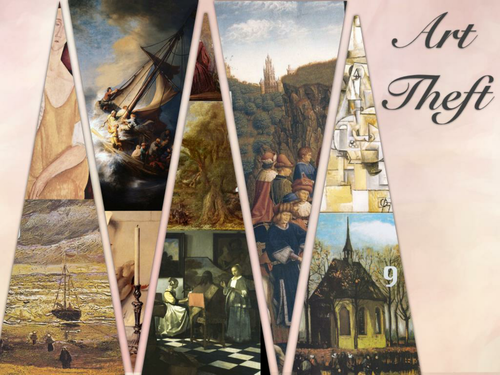











This is a powerpoint presentation of this topic and includes the top cases from the field. It is followed by a 20 point multiple choice test (with answer key) and a 35 card set of Flash Cards. These Flash Cards can be used for review, testing or to facilitate class discussion. An answer key is included.
---I am a retired lawyer, instructor and textbook writer.
some EXCERPTS from the show:
~Operation Cobalt: This was a secret plan to buy back the Turner paintings from the thieves. A Scotland Yard undercover agent contacted lawyer Edgar Liebrucks who began to negotiate with the Mafia on behalf of Tate. The first deal went through for 5 million Deutsche Marks. “Shade and Darkness” returned to London in July 2000. Liebrucks received about 320,000 euros as his compensation. In 2002 two men who were storing the other Turner contacted Liebrucks and sold it back to Tate for 2 million euros. It returned to London in Christmas 2002. The Tate Gallery received more from the insurers than it paid to the thieves so it made a substantial profit.
~ Gardner Museum, Boston: The largest art theft in world history occurred in Boston on March 18, 1990 at the Isabella Stewart Gardner Museum in Boston. Thieves stole 13 pieces. which in 2015 have escalated in worth to over $500 million. Two men outside pressed the door buzzer and ordered: "Police! Let us in. We heard about a disturbance in the courtyard." The guard, Abath, said he knew he should not let uninvited guests inside, but he was unsure on whether the rule applied to police officers. His partner was on patrol. Abath buzzed in the men. The thieves bound the guards in the museum's basement. The museum’s motion detectors recorded the thieves' movements throughout the museum as they stole the art. The FBI announced in August 2015 that the two men who had robbed the Gardener Museum were dead. It would not disclose who they were. The FBI continued the hunt for the missing art work.
~ NYPD Art Unit: Detective Mark Fishstein became the department's art-crime detective in June 2003. He followed in the footsteps of Detective Robert Volpe, who spent decades as the NYPD's resident art expert, who recovered many art masterpieces. Fishstein’s family were art connoisseurs, with his father being a commercial artist and both parents being antique dealers and collectors. His potential was noticed by the department when as a patrolman he identified a Picasso drawing hanging in the apartment of a recent decedent discovered there. He also holds onto unsolved cases because they might eventually appear at auction. Some art thieves (mistakenly) believe that if enough time goes by, that it is probably safe to sell art.
---I am a retired lawyer, instructor and textbook writer.
some EXCERPTS from the show:
~Operation Cobalt: This was a secret plan to buy back the Turner paintings from the thieves. A Scotland Yard undercover agent contacted lawyer Edgar Liebrucks who began to negotiate with the Mafia on behalf of Tate. The first deal went through for 5 million Deutsche Marks. “Shade and Darkness” returned to London in July 2000. Liebrucks received about 320,000 euros as his compensation. In 2002 two men who were storing the other Turner contacted Liebrucks and sold it back to Tate for 2 million euros. It returned to London in Christmas 2002. The Tate Gallery received more from the insurers than it paid to the thieves so it made a substantial profit.
~ Gardner Museum, Boston: The largest art theft in world history occurred in Boston on March 18, 1990 at the Isabella Stewart Gardner Museum in Boston. Thieves stole 13 pieces. which in 2015 have escalated in worth to over $500 million. Two men outside pressed the door buzzer and ordered: "Police! Let us in. We heard about a disturbance in the courtyard." The guard, Abath, said he knew he should not let uninvited guests inside, but he was unsure on whether the rule applied to police officers. His partner was on patrol. Abath buzzed in the men. The thieves bound the guards in the museum's basement. The museum’s motion detectors recorded the thieves' movements throughout the museum as they stole the art. The FBI announced in August 2015 that the two men who had robbed the Gardener Museum were dead. It would not disclose who they were. The FBI continued the hunt for the missing art work.
~ NYPD Art Unit: Detective Mark Fishstein became the department's art-crime detective in June 2003. He followed in the footsteps of Detective Robert Volpe, who spent decades as the NYPD's resident art expert, who recovered many art masterpieces. Fishstein’s family were art connoisseurs, with his father being a commercial artist and both parents being antique dealers and collectors. His potential was noticed by the department when as a patrolman he identified a Picasso drawing hanging in the apartment of a recent decedent discovered there. He also holds onto unsolved cases because they might eventually appear at auction. Some art thieves (mistakenly) believe that if enough time goes by, that it is probably safe to sell art.
Something went wrong, please try again later.
This resource hasn't been reviewed yet
To ensure quality for our reviews, only customers who have purchased this resource can review it
Report this resourceto let us know if it violates our terms and conditions.
Our customer service team will review your report and will be in touch.
$5.00